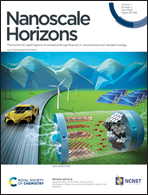Flexible InP–ZnO nanowire heterojunction light emitting diodes†
Abstract
Flexible, substrate-free nanowire (NW) devices are desirable to overcome the extremely challenging task of integrating III–V or III–N semiconductor devices such as LEDs and lasers on a range of optoelectronic circuits or biochips. In this work, we report the demonstration of core–shell p-InP/n-ZnO heterojunction NW array LEDs. The emission from the devices consists of three peaks at room temperature due to conduction band-to-heavy hole band transition, conduction band-to-light hole band transition and recombination at the substrate. At 78 K, an additional peak due to Zn acceptor levels is observed, whereas the peak due to the conduction band-to-light hole band transition quenches. Flexible LEDs are then fabricated by embedding the NW arrays in SU-8 to enable subsequent lift-off from the substrate. Compared with the original on-substrate LED device, broader, red-shifted and multiple peaks are observed from the flexible devices, which may be due to non-uniform strain related effects in the NWs caused by the SU-8 film. A slightly higher series resistance as compared to the on-substrate device and significant Joule heating suggest that good heatsinking is required for these flexible devices. Nevertheless, our study paves a promising way towards flexible and low power LEDs.

- This article is part of the themed collection: Nanoscale Horizons and Nanoscale: Nanomaterials for Energy


 Please wait while we load your content...
Please wait while we load your content...